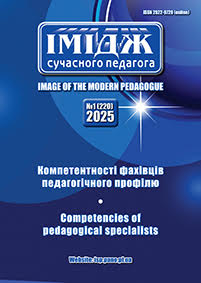Психоедукація та психосоціальна підтримка родинам, дітям і підліткам, які переживають втрату: профілактика ускладненого горя
DOI:
https://doi.org/10.33272/2522-9729-2025-1(220)-82-86Ключові слова:
психоедукація; горе і втрата; багатовимірна теорія горя; адаптивна та дезадаптивна реакція горя; психосоціальна підтримка дітям і підліткамАнотація
Розглянуто різні психологічні теорії розуміння специфіки психології горювання, проаналізовано публікації останніх років щодо багатовимірної теорії горя, подвійного процесу подолання, ознак адаптивного та дезадаптивного горя.
Сформульовано висновки з дослідження потреби населення України у психоедукації, з метою зростання стійкості, подолання стресу від повномасштабної війни і втрат, допомоги родинам і дітям загиблих військових у переживанні горя.
Визначено основні напрями психологічної просвіти; надано рекомендації батькам, учителям, соціальним працівникам і широкому загалу щодо профілактики дезадаптивного горя у дорослих, дітей і підлітків, які переживають втрату близької людини.
Посилання
References
Alvord, M. K., Gurwitch, R., Martin, J., & Palomares, R. S. Resilience for teens: 10 tips to build skills on bouncing back from rough times. 2011-2020. Retrieved from https://www.apa.org/topics/resilience/bounce-teens
Alvis, L., Oosterhoff, B., Giang, C., & Kaplow, J. B. (2023). A pilot open trial of an individualized adaptation of Trauma and Grief component therapy (TGCT) in children. Child & Youth Care Forum, 53 (4), 893-908. DOI: https://doi.org/10.1007/s10566-023-09776-3
Chandra, A., Burns, R. M., Tanielian, T., & Jaycox, L. H. (2010). Understanding the Deployment Experience for Children and Youth from Military Families. In Springer eBooks (pp. 175-192). DOI: https://doi.org/10.1007/978-1-4419-7064-0_9
Chandra, A., Burns, R., Tanielian, T,. Jaycox, L., & Scott, M. (2008). Understanding the impact of deployment on children and families: Findings from a pilot study of Operation Purple Camp participants. Santa Monica, CA: Rand Corporation.
DeAngelis, T. Thousands of kids lost loved ones to the pandemic. Psychologists are teaching them how to grieve, and then thrive. Retrieved from https://www.apa.org/monitor/2022/10/kids-covid-grief
GRIEF & TRAUMA RESOURCES | drrobingoodman1. (n.d.). Drrobingoodman1. Retrieved from https://www.drrobingoodman.com/covid-19-resources-new-page
Harris, D. L. (Ed.). (2019). Non-death Loss and Grief: Context and Clinical Implications. Routledge.
Helping children and adolescents cope with death or tragedy. Drrobingoodman. Retrieved from www.drrobingoodman.com/_files/ugd/0b286f_7cc02614a90248979ea30bfde7593ecpdf
Kaplow, J. B., Layne, C. M., Howell, K., & Pynoos, R. S. (2011). Developmental considerations for DSM-5 bereavement-related disorders. In C. M. Layne (Ed.), Developmental perspectives on DSM-5 bereavement criteria: Three longitudinal studies of bereaved children and adolescents. Baltimore, MD: Symposium presented at the International Society for Traumatic Stress Studies Meeting.
Kaplow, J., Layne, C., Howell, K., Lerner, E., Merlanti, M., & Pynoos, R. (2012). Psychometric properties and correlates of the Multidimensional Grief Reactions Scale. In C. M. Layne (Ed.), Integrating Developmentally-Informed Theory, Evidence-Based Assessment, and Evidence-Based Treatment of Childhood Maladaptive Grief. Los Angeles, CA: Symposium presented at the International Society for Traumatic Stress Studies Meeting.
Layne, C. M., Beck, C. J., Rimmasch, H., Southwick, J. S., Moreno, M. A., & Hobfoll, S. E. (2008). Promoting “resilient” posttraumatic adjustment in childhood and beyond: “Unpacking” life events, adjustment trajectories, resources, and interventions. In Routledge eBooks (pp. 31-66). DOI: https://doi.org/10.4324/9780203893104-8
Layne, C. M., & Kaplow, J. B. (2012). The Bereavement Risk and Resilience Index (BRRI). Los Angeles: University of California. Unpublished psychological test.
Park, N. (2011). Military children and families. American Psychologist, 66, 65-72. [PubMed: 21219050]. Retrieved from https://psycnet.apa.org/doi/10.1037/a0021249
Pinchuk, O. (2024). Psychological education: international experience in improving mental health and developing the psychological culture of young people. Image of the Modern Pedagogue, 1(6), 76-79. DOI: https://doi.org/10.33272/2522-9729-2024-6(219)-76-79
Resilience in a time of war: Tips for parents and teachers of teens. (2023, October 16). https://www.apa.org. Retrieved from https://www.apa.org/topics/resilience/teen-war
Saltzman, W. R., Lester, P., Beardslee, W. R., Layne, C. M., Woodward, K., & Nash, W. P. (2011). Mechanisms of risk and resilience in military families: Theoretical and empirical basis of a family-focused resilience enhancement program. Clinical Child and Family Psychology Review, 14, 213-230. [PubMed: 21655938]. Retrieved from https://link.springer.com/article/10.1007/s10567-011-0096-1
Saltzman, W. R., Pynoos, R. S., Layne, C. M., Steinberg, A. M., & Aisenberg, E. (2001). Trauma- and grief-focused intervention for adolescents exposed to community violence: Results of a school-based screening and group treatment protocol. Group Dynamics Theory Research and Practice, 5 (4), 291-303. DOI: https://doi.org/10.1037/1089-2699.5.4.291
Sesame Workshop. (2023, November 14). Elmo and Jesse remember Uncle Jack - Sesame workshop. Retrieved from https://sesameworkshop.org/resources/elmo-and-jesse-remember-uncle-jack/
Weir, K. (n.d.). Grieving life and loss. Retrieved from https://www.apa.org/monitor/2020/06/covid-grieving-life
Wiens, T. W., & Boss, P. (2006). Maintaining family resiliency before, during, and after military separation. In C. A. Castro, A. B. Adler, T. W. Britt (Eds.), Military life: The psychology of serving in peace and combat (Vol. 3, p 13). Westport, CT: Praeger Security International.
##submission.downloads##
Опубліковано
Як цитувати
Номер
Розділ
Ліцензія
Авторське право (c) 2025 Імідж сучасного педагога

Ця робота ліцензується відповідно до Creative Commons Attribution-NonCommercial-ShareAlike 4.0 International License.
Автори, які публікуються у цьому журналі, погоджуються з наступними умовами:- Автори залишають за собою право на авторство своєї роботи та передають журналу право першої публікації цієї роботи на умовах ліцензії Creative Commons Attribution License, котра дозволяє іншим особам вільно розповсюджувати опубліковану роботу з обов'язковим посиланням на авторів оригінальної роботи та першу публікацію роботи у цьому журналі.
- Автори мають право укладати самостійні додаткові угоди щодо неексклюзивного розповсюдження роботи у тому вигляді, в якому вона була опублікована цим журналом (наприклад, розміщувати роботу в електронному сховищі установи або публікувати у складі монографії), за умови збереження посилання на першу публікацію роботи у цьому журналі.
- Політика журналу дозволяє і заохочує розміщення авторами в мережі Інтернет (наприклад, у сховищах установ або на особистих веб-сайтах) рукопису роботи, як до подання цього рукопису до редакції, так і під час його редакційного опрацювання, оскільки це сприяє виникненню продуктивної наукової дискусії та позитивно позначається на оперативності та динаміці цитування опублікованої роботи (див. The Effect of Open Access).



